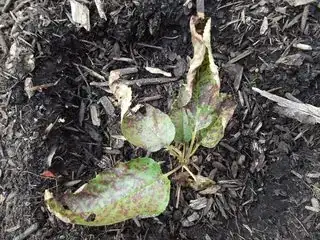There is no cause to throw this plant away. None.
As you noted in a previous question, it came into your garden with a leaf-spot problem which got much worse in the weeks following transplanting. Given that you transplanted at the end of the growing season, this is not unusual nor is it particularly worrisome.
Cherries grown from seed often have tap roots and so was likely a bit unhappy in a pot. Being transplanted late in the season, added to the plant's stress. Leaf spot diseases (both fungal and bacterial) are opportunistic. They primarily affect the older leaves of plants under stress. Given the date, all the leaves on your cherry qualify as older leaves. Hence the seriousness of this infection is not surprising.
Since the defoliation the leaf spot is causing is happening only a couple weeks before normal autumn leaf drop, it is doing the plant no harm. Really. Serious leaf spot infections are a big deal when they occur earlier in the season. They can affect the new growth, they can ruin the fruit, and, most importantly, if they defoliate the tree, the tree will be forced to push out a new set of leaves. This can seriously deplete the tree stored food supply. However, a leaf spot problem this late is just encouraging early dormancy — not a serious cause for concern.
The cherry's stem appears healthy. The bud at the tip looks fat and healthy. So I see no reason the plant will not do fine next spring. Leaf spot diseases generally do not winter over in the plant. Therefore, if you remove the leaves and dispose of them, the leaf spot problems may not reappear.
If you have a serious leaf spot problem next year, then, maybe, you will have a good reason to get rid of the the plant. Even then, I would look first at cultural issues that may make the plant more susceptible to problems. Is it in too much shade? Does the soil drain well? Does the air circulate well where it is growing? If this area is a bad place to grow a cherry seedling, it will not be much better for growing second year cherry stock from a nursery.

